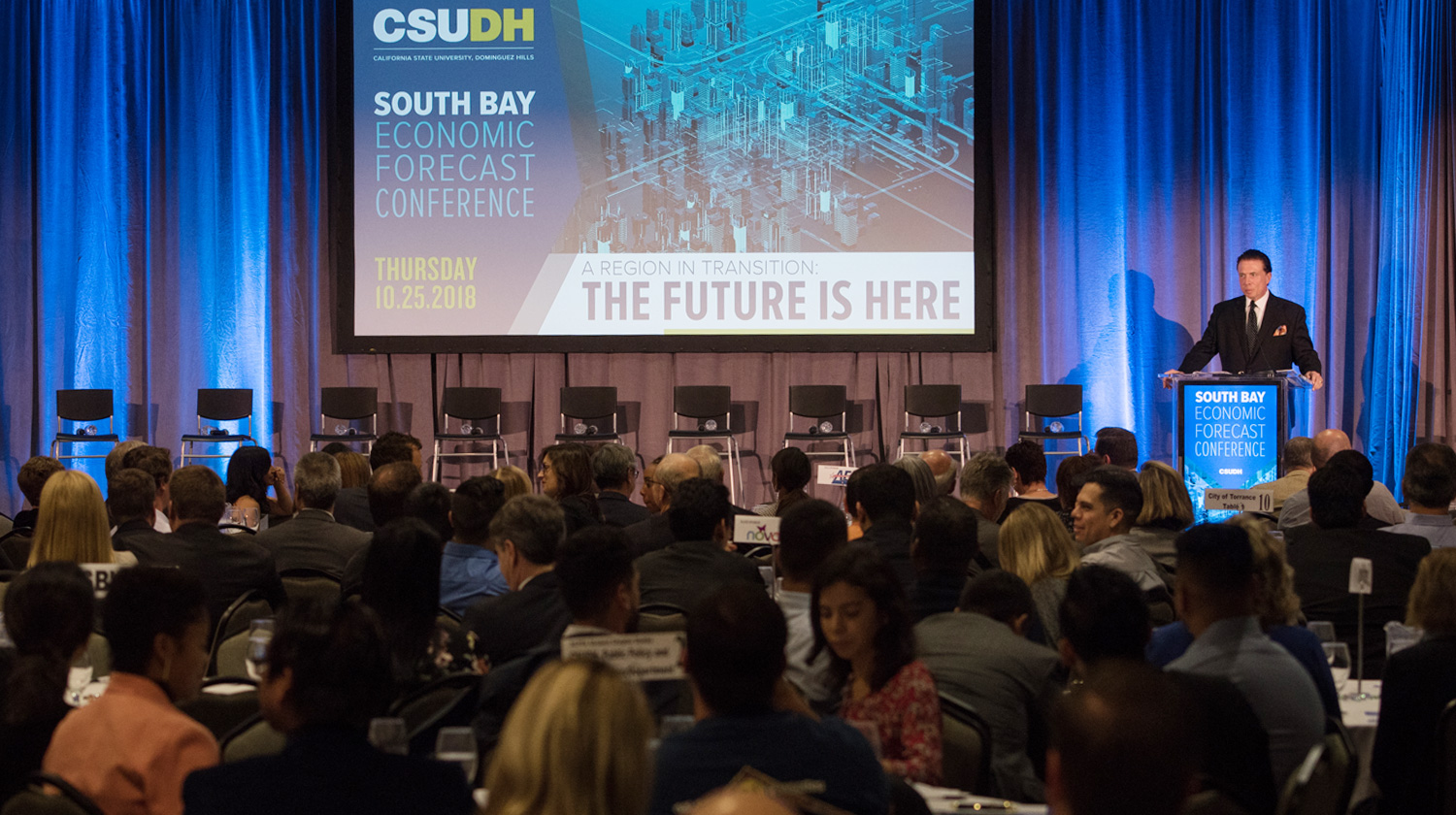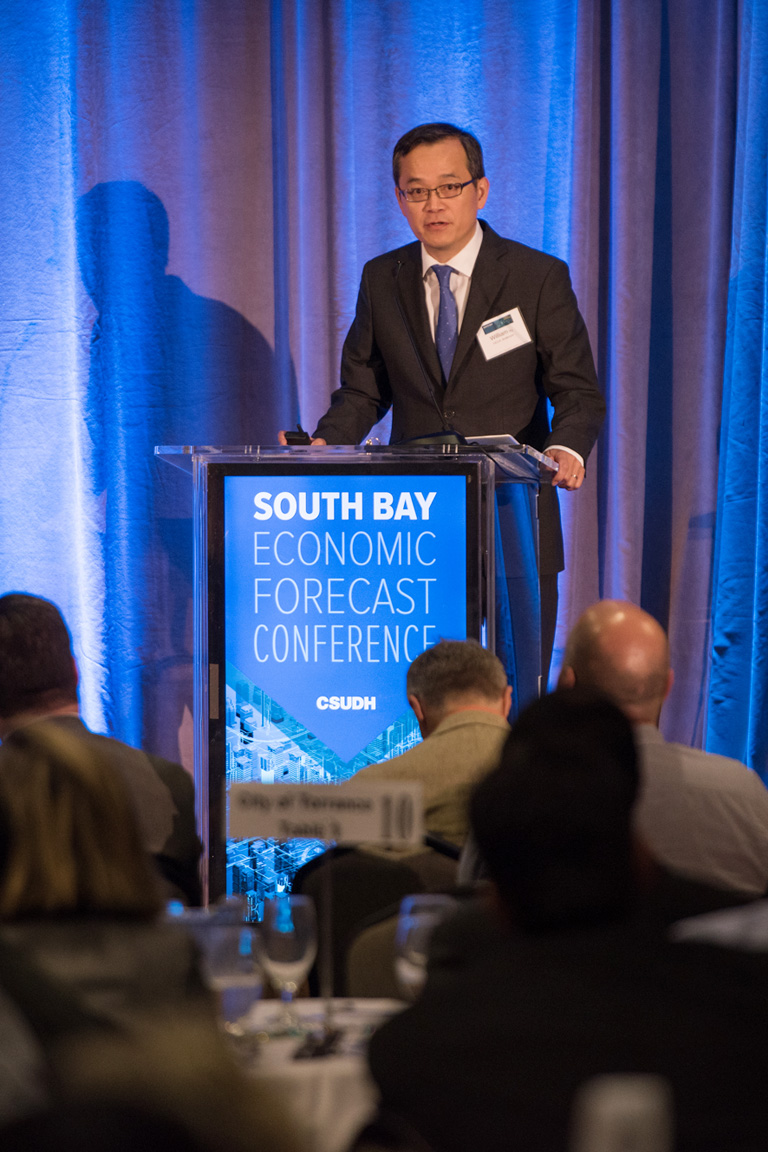
As predicted during last year’s conference, California State University, Dominguez Hills’ (CSUDH) 2018-19 South Bay Economic Forecast showed that the economy remains strong, and though the region’s status of “full-employment” has resulted in slightly slower job growth in recent years, employment growth in 2017 overall increased to a more stable 1.4 percent.

Titled “A Region in Transition: The Future is Here,” the fourth annual South Bay Economic Forecast and Industry Outlook conference took place at CSUDH on Oct. 25. Hosted by Frank Mottek, anchor for KNX 1070 NEWSRADIO, the economic forecast provided a wide-ranging, data-driven report on the current state of the South Bay, as well as the outlook for 2019.
The economic report was developed and presented by William Yu, an economist for the UCLA Anderson Forecast. He found the South Bay’s economy and job creation was slightly slower than Los Angeles County and the state last year, but it still outpaced the nation as a whole.
“As the southern part of Silicon Beach, the South Bay is one of the more dynamic regions in Southern California,” said Yu. “The most important driver of South Bay’s economy is the manufacturing sector, and its crown jewel is the aerospace and defense industry.”
Yu predicts that the South Bay will continue to see growth well into 2019, mostly due to the expansion of the federal government’s defense budget, and major enterprises such as SpaceX and the new Los Angeles Stadium and Entertainment District at Hollywood Park as they continue to transform and advance the local economy.
“The South Bay will continue to offer high paying jobs in all sectors with high human capital. Household incomes will grow fast. The outlook for the region is very good,” said Yu
Off to Work
The average annual wage of a worker in the South Bay was slightly lower in 2017 at $61,700, but it remained higher than LA County, which was at $58,880. Manufacturing in the aerospace sector was up last year 5.5 to 38,200 jobs, and the computer and electronic products sector grew 2.4 percent from 42,100 to 43,100 jobs.
South Bay wages by industry in 2017:
• information, $115,000;
• professional, scientific, and technical service sectors: $105,000;
• finance: $101,000;
• manufacturing, $91,000;
• health care and social services, $46,000;
• retail, $36,000;
• accommodations and food services, $23,000.
The South Bay employed approximately 445,000 individuals during the third quarter of 2017, representing nearly one-tenth of the county’s workforce, and while manufacturing is king in the region as far as value added to the local economy, its average overall growth of 1.5 percent per year since 2011 did slow to 0.5 percent in 2016-17, according to Yu.
Total manufacturing wages topped out at nearly $1.52 billion, according to the economic report. This represents close to 67,000 jobs, and is nearly double the $800 million in wages paid in the professional, scientific, and technical services sector. Health care and social services rounded out the top three at $570 million.

The economic report also found the highest concentration of manufacturing jobs to be located in El Segundo and Hawthorne, where several aerospace and defense companies are located, including Raytheon, Northrop Grumman, Boeing, and SpaceX. Torrance-based Honda is also a major manufacturer employing many workers in South Bay.
Yu’s research also found the highest median household income in the South Bay in 2018 to be in coastal cities–Manhattan Beach and Rancho Palos Verdes are home to the highest earners–compared to the region’s inland cities. One exception was the area surrounding CSUDH, as household income correlates with education levels and housing value. Overall, the education service sector in LA County has also shown robust growth in recent years.
Future is Here in the South Bay
Following Yu’s economic forecast report, the afternoon conference featured its Future is Here panel of speakers representing local innovative technology and automotive companies. Each gave a presentation of their industry and then took questions in a panel discussion of such trends as new media, smart cities, and personal mobility.

From the private sector, the speakers included Aziz Ucmakli, principal research analyst, and Mathew Staal, senior engineer and new business adviser, at Honda R&D Americas, Inc.; Heidi Pease, co-founder of Los Angeles Blockchain Lab in Santa Monica; CSUDH alumna Bree Nguyen, head of talent and creator partnerships at Facebook; and Shan Sundar, founder and chairman of Edgesoft, Inc. in Manhattan Beach.
After the conference program, Honda demonstrated its new autonomous 3E-D18 Robotic Workhorse, which features a range of experimental technologies engineered to understand people’s needs and demonstrate how robotics and people can work together.
“The year 2021 will be a big year for companies applying more self-driving technology, but there are actually five levels of autonomous driving technology, and right now we are only on level two or three,” said Pete Wendt, project manager, advanced product planning at Honda. “In some [autonomous] cars today you don’t really have to be that attentive and can have your hands off the wheel. However, you still need to be ready to take over when needed. So I think it’s going to be much further out when we see what some people call the ‘robotaxi;’ a car with no steering wheel.”
The quality of faculty-led research was also on display at the Economic Forecast. Fynnwin Prager, assistant professor of business administration and co-director of CSUDH’s South Bay Economics Institute, discussed entrepreneurship and findings from the institute’s economic development study on 200+ Southern California cities.
Jose Martinez, assistant professor of economics and co-director of the institute, provided updates on the South Bay housing market. He also shared the institute’s latest data on telework (working from home or remotely) and its effect on traffic, travel time, and housing trends.
“Housing and traffic are directly connected to economic development, so if we don’t address the issues we have now I don’t think the local economy will be able to sustain its growth,” said Martinez. “We are trying to attract the brightest minds in the world to the region. The question is how do we attract them to an area that is very expensive, and that takes an hour and a half to get to work? This is a big issue in the South Bay.”
